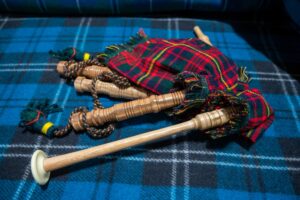Tartan is one of Scotland's most iconic symbols, a patterned fabric woven with pride, heritage, and history. From ancient Highland roots to modern fashion runways, it has evolved into a global emblem of Scotland. Its bold colours and criss-crossed lines tell a deeper story tied to clans, rebellion, and tradition.
A patterned fabric of horizontal and vertical bands in multiple colours, woven to form a distinctive check design. Each pattern, known as a sett, is repeated across the fabric and can be unique to a family, organisation, or region.
Traditionally made from wool, it is now produced in various materials and is used in kilts, scarves, trousers, and more. Although often mistaken for "plaid," Tartan refers specifically to patterns rooted in Scottish history.
In Scotland, you will find our famous fabric worn in tradition at weddings, ceilidhs, Highland Games, and national events such as the Edinburgh Military Tattoo.
Its roots stretch back centuries, with evidence of early tartan-like fabrics dating to around the 3rd century AD. In the Scottish Highlands, local weavers used natural plant dyes to create unique patterns inspired by the surrounding landscape.
Its role in Scottish identity became especially significant during the Jacobite uprisings of the 18th century. After the defeat at the Battle of Culloden in 1746, the British government passed the Dress Act, banning the wearing of Highland dress, which included Tartan. A law that was designed to suppress Highland culture and rebellion.
The ban was lifted in 1782, and by the 19th century, Tartan had undergone a romantic revival. The Victorians, along with Queen Victoria and Prince Albert, embraced Highland style, helping to popularise Tartan throughout Britain and beyond.
Many Scottish clans have one or more tartans associated with their family name. These patterns often represent pride, loyalty, and a connection to ancestry. Some clans have several versions, including hunting tartans (with muted tones), dress tartans (lighter or more decorative), and modern designs.
While some have historical roots, many were formalised during the 19th century following the Highland revival. Today, wearing your clan colours is a way to celebrate your family heritage. You don't need to belong to a clan to wear Tartan proudly.
Originally, the came from natural dyes, heather, berries, tree bark, and roots, giving Highland tartans an earthy tone. With the introduction of synthetic dyes in the 19th century, they became brighter and more varied.
The colours and patterns may represent specific landscapes, family stories, or values. The sett (pattern) defines the Tartan and is registered to ensure consistency in weaving.
Tartan remains a visible and celebrated part of Scottish life. It's worn at formal events like weddings and Burns Night suppers, and features prominently at the Highland Games. Many schools, pipe bands, and military regiments also wear unique tartans.
Beyond tradition, it has its place in global fashion. Legally protected through the official registration available through the Scottish Register of Tartans.
Scotland is still home to several traditional weaving mills that continue to produce authentic tartans using time-honoured techniques. Historic mills like Lochcarron of Scotland and The House of Edgar in Perth. Weave tartans for clans, retailers, and special events worldwide. These mills help preserve the craftsmanship while blending it with modern design and innovation.
An annual celebration in countries such as the United States, Canada, Australia and New Zealand, which is held annually on the 6th of April. It commemorates the signing of the Declaration of Arbroath in 1320 and honours the contributions of Scots abroad.
Parades, pipe bands, and Highland Dancing are all part of the celebrations, with locals joining the fun and proudly wearing Tartan to celebrate their ancestry or connections to Scotland.

Tartan refers to specific patterns associated with clans or regions in Scotland, while plaid is a broader term used more commonly in North America for any checked pattern.
Most traditional clans have one or more official tartans, though many were formalised in the 19th century rather than being ancient. Some clans have multiple versions, such as hunting, dress, or modern tartans.
Yes, anyone can wear it. While clan tartans have symbolic meaning, many wear tartans to broadly celebrate Scottish heritage. Regardless of ancestry, there are also universal tartans designed for anyone to wear.
Historically, the colours came from local plant dyes and had no fixed meaning. Today, colours may symbolise regions, values, or clan stories, but meanings are often applied more recently rather than being original features.
Absolutely. Scots proudly wear kilts at weddings, ceilidhs, national celebrations, and Highland Games. It's also used in military uniforms, school kilts, pipe bands, and increasingly in modern fashion.
Yes, you can design your own! Individuals, families, businesses, and organisations often create custom tartans to represent their identity or mark a special occasion. Once developed, you can register it officially with the Scottish Register of Tartans, provided it meets their criteria for uniqueness. There are also online tools and professional weavers who can help bring your design to life.
Yes, many are still woven in Scotland by traditional mills. These include family and clan tartans as well as custom designs for events, brands, or fashion collections.
